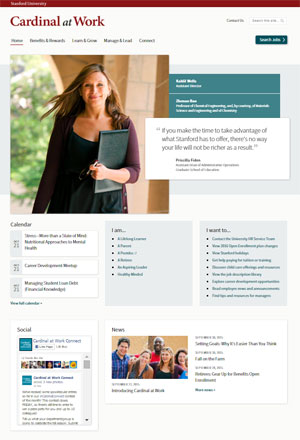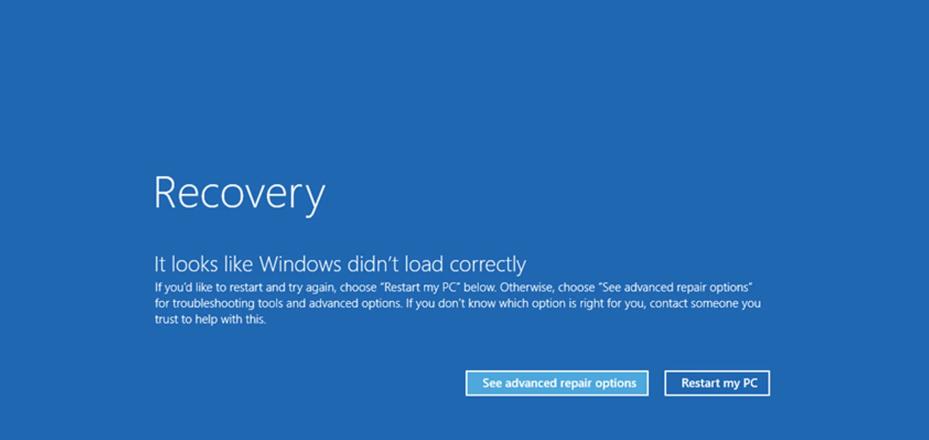Behind the Cardinal at Work Website
Up front, the Cardinal at Work website is a robust, new resource that centralizes Stanford’s employee-related information for its 16,000 faculty and staff. If you dig a bit deeper, you’ll also uncover how a business unit or school can leverage the expertise of University IT to make great things happen.
Cardinal at Work replaces more than 10 independent websites owned by University Human Resources (UHR) with a single, coordinated, 500-plus page Drupal website loaded with new and improved features.
To accomplish this major feat, UHR collaborated primarily with Stanford Web Services (SWS), a University IT team that designs and builds websites and website tools for the Stanford community. For SWS, the multi-year project included providing strategic guidance during the planning phase, creating a new, mobile-responsive design that meets university identity and accessibility standards, and developing numerous reusable Drupal 7 features.
“Our focus is to work across campus to advance the goals of our clients, while creating assets — such as Drupal features and design templates — that will benefit all of the university,” said Sara Worrell-Berg, manager of SWS.
Other University IT teams also contributed to this cross-organizational website development and launch project. The Emerging Technologies team helped SWS deliver the website in a new cloud-based hosting environment, and the Infrastructure Services team provided support for virtual host switching on launch day.
“University IT teams regularly partner on projects like this one, each contributing specialized expertise to strengthen the end result,” said Kim Seidler, Executive Director of Consulting Services for University IT, who oversees SWS.
Build and Scale
Creative thinking, efficiency, and scalability are inherent in the SWS process, propelling the team to build affordable websites and website features for clients that can be reused for other clients across the university.
“Throughout the course of the Cardinal at Work website development, we watched for features that we knew others on campus already needed or might want in the future,” said Linnea Williams, SWS web project manager. “We actively sought other stakeholder input where possible to make tools that were flexible and reusable.”
Already, SWS leveraged some of these features on other university websites and rolled others into the Stanford Sites Jumpstart product. Four features from the Cardinal at Work website that are now - or soon will be - reused are:
FAQ Feature
Built with advising and testing from the campus accessibility specialist, this feature makes expandable frequently asked question (FAQ) items and lists them on a page in optional groupings.
See it in action on the Cardinal at Work website. Stay tuned for how this feature will be used on a new website for the Redwood City Campus.
Faceted Search
This feature uses external hosting and indexing for the content to allow for rich, detailed, and fast search results. It also allows filtering of search results by categories. There is now a standard protocol for how to approach this sort of work for campus and reusable configuration in place.
See this feature in action on the Cardinal at Work website and how it is reused on Introductory Seminars course catalog.
Gallery Feature
This flexible tool creates a page of thumbnails that pop up into a lightbox when a user clicks on them. There are four different size options depending on how an area wants to use the gallery. Extensively tested for accessibility, this fun feature will roll out in the spring on the Cardinal at Work website, will be added to the Jumpstart product soon, and is in the pipeline to be used by the School of Humanities and Sciences this fall.
Subsite V2
The subsite feature is used to create “mini-websites” within websites by allowing for a section of the site to contain a customized design, logo, site title, and navigation. Because all subsites are within the same web property and database, sharing content like news and events is much easier than if every site is built as a separate entity. In addition, it provides an easy-to-manage single user/editor base, plus upgrades only need to be made once for the suite of sites - reducing the overall maintenance effort. Subsite was first developed in 2013 for the Vice Provost for Undergraduate Education’s (VPUE) many programs, then leveraged by Stanford Earth.
For version 2, SWS interviewed the existing users and - from that feedback - made substantial gains in the administrative experience, now deployed on the Cardinal at Work website. Next, the feature will be used on the new IRiSS website, currently in development, for various labs and centers.
“Unlike working with outside website design and development vendors, working with Stanford Web Services takes the burden off our own communications team. We can focus on our content, knowing SWS is responsible for - and experts at - building websites that meet university accessibility and identity standards, work on any device and browser, and integrate new features that we request,” said Valerie Beeman, Communications Director for University Human Resources.“What’s more, it feels good to partner internally because we know the work SWS does with us can benefit others on campus, too.”
DISCLAIMER: UIT News is accurate on the publication date. We do not update information in past news items. We do make every effort to keep our service information pages up-to-date. Please search our service pages at uit.stanford.edu/search.




